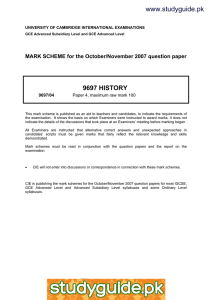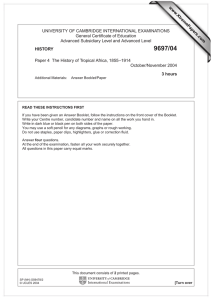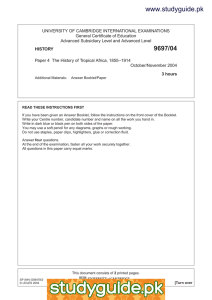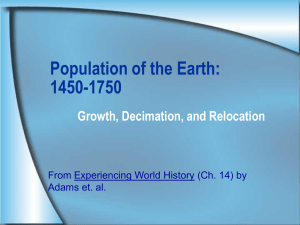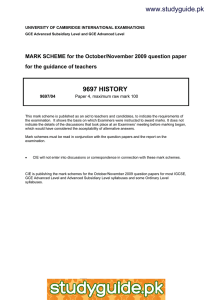9697 HISTORY MARK SCHEME for the October/November 2007 question paper
advertisement
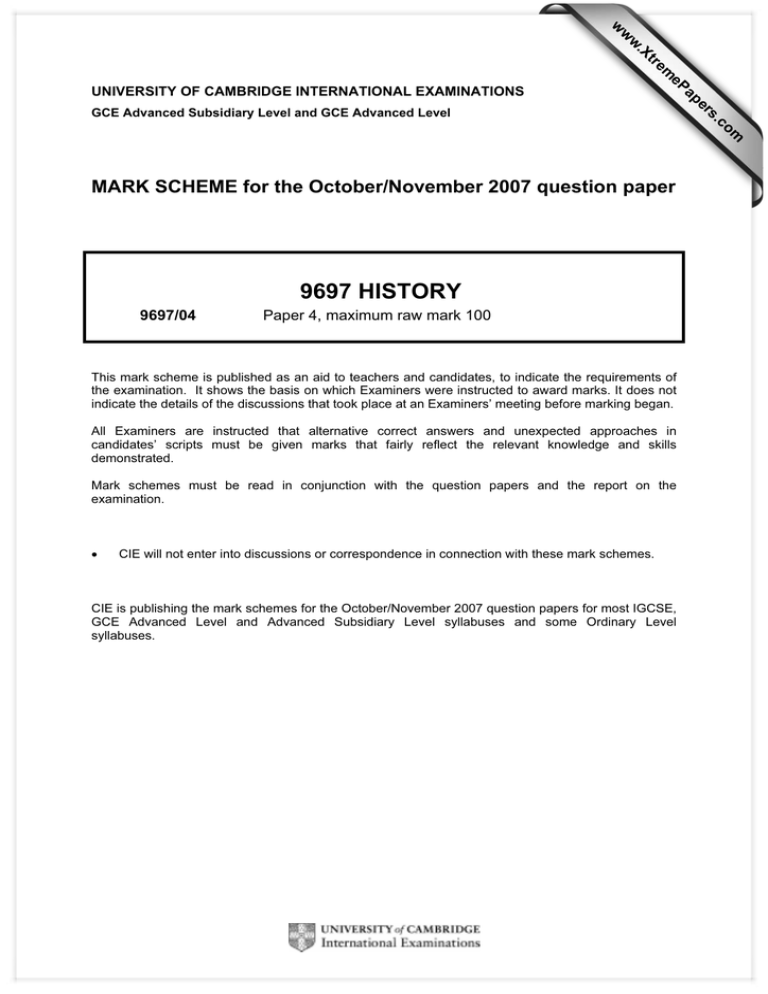
w w ap eP m e tr .X w UNIVERSITY OF CAMBRIDGE INTERNATIONAL EXAMINATIONS 9697 HISTORY 9697/04 Paper 4, maximum raw mark 100 This mark scheme is published as an aid to teachers and candidates, to indicate the requirements of the examination. It shows the basis on which Examiners were instructed to award marks. It does not indicate the details of the discussions that took place at an Examiners’ meeting before marking began. All Examiners are instructed that alternative correct answers and unexpected approaches in candidates’ scripts must be given marks that fairly reflect the relevant knowledge and skills demonstrated. Mark schemes must be read in conjunction with the question papers and the report on the examination. • CIE will not enter into discussions or correspondence in connection with these mark schemes. CIE is publishing the mark schemes for the October/November 2007 question papers for most IGCSE, GCE Advanced Level and Advanced Subsidiary Level syllabuses and some Ordinary Level syllabuses. om .c MARK SCHEME for the October/November 2007 question paper s er GCE Advanced Subsidiary Level and GCE Advanced Level Page 2 Mark Scheme GCE A/AS LEVEL – October/November 2007 Syllabus 9697 Paper 04 Marking Bands for Essay Questions Examiners will assess which marking band best reflects the quality of the answer. They should not. expect answers to show all the qualities included within the band description. The choice of mark within the band will depend on' the quality of the analysis and the amount of supporting information. Essays in Bands 1–3 will clearly be question-focused, whereas answers in lower bands will show a primary concern with the topic rather than with the specific question asked. However, a question focus is not sufficient in itself to place an essay in Bands 1–3; this must also be accompanied by sufficient accurate, relevant supporting material. Band Marks Quality of the answer 1 21–25 The approach will be consistently analytical or explanatory rather than descriptive or narrative. Essays will be fully relevant. The argument will be structured coherently and supported by appropriate factual material. The writing will be accurate. At the lower end of the band, there may be some weaker sections to the answer, but the overall quality will show that the candidate is in control of the argument. The best answers must achieve 25 marks. 2 18–20 Essays will be focused clearly on the demands of the question but there will be some unevenness. The approach will be mostly analytical or explanatory rather than descriptive or narrative. The answer will be mostly relevant. Most of the argument will be structured coherently and supported by largely accurate factual material. The impression will be that a good solid answer has been provided. The writing will be mostly accurate. 3 16–17 Essays will reflect a clear understanding of the question, and constitute a fair attempt to provide an argument and factual knowledge to answer it. The approach will contain analysis or explanation, but there may be some heavily narrative or descriptive passages. The answer will be largely relevant. Essays will achieve a genuine argument but may lack balance or depth of factual knowledge. Most of the answer will be structured satisfactorily but some parts may lack full coherence. The writing will be generally accurate. 4 14–15 Essays will indicate attempts to argue relevantly, though often only implicitly. The approach will depend more on some heavily descriptive or narrative passages than on analysis or explanation, which may be limited to introductions and conclusions. Factual material, sometimes very full, will be used to impart information or describe events rather than to address directly the requirements of the question. The structure of the argument could be organised more effectively. The writing will usually be accurate. 5 11–13 Essays will offer some appropriate elements but there will be little attempt generally to link factual material to the demands of the question. The approach will lack analysis and the quality of the description or narrative, although sufficiently accurate and relevant to the topic if not the particular question, will not be linked effectively to the argument. The structure will show weaknesses and the treatment of topics within the answer will be unbalanced. The writing may show some accuracy but there will also be frequent errors. 6 8–10 Essays will not be properly focused on the requirements of the question. There may be many unsupported assertions and commentaries which lack sufficient factual support. The argument may be of limited relevance to the topic and there may be confusion about the implications of the question. The writing will show significant weaknesses. 7 0–7 Essays will be characterised by significant irrelevance or arguments which do not begin to make significant points. The answers may be largely fragmentary and incoherent. The writing will show very significant weakness. Marks at the bottom of this band will be given very rarely because even the most wayward and fragmentary answers usually make at least a few valid points. © UCLES 2007 Page 3 Mark Scheme GCE A/AS LEVEL – October/November 2007 Syllabus 9697 Paper 04 N.B. These notes should be read and used in conjunction with the Marking Band Descriptions. They should not be regarded as 'model' or 'correct' answers. They suggest the content and approach which would constitute a good, relevant and appropriate answer. They also attempt to identify the mark band which would best fit different types of answer. This is difficult in History where there are as many different answers to essay questions as there are candidates. For this reason the Marking Band Descriptions may be the best guide to the most appropriate mark for an answer. 1 Why did the slave trade, from and within East and West Africa, continue into the second half of the nineteenth century? The key word here is 'Why' and answers will need to cover the reasons for the continuation of the slave trade from and within both regions to earn a mark in one or other of the three top mark bands. Use Marking Band Descriptions to distinguish between the three top bands. Omission of one of the two regions will effectively halve the possible marks. Lack of a reasonable balance between the two will significantly lower the possible total mark. Some of the reasons apply equally to both regions (e.g. the difficulty of mounting an effective naval blockade to stop the export of slaves; or the need for cheap slave labour to cultivate plantation crops like palm trees in Dahomey and the states of the Niger Delta; or cloves in Pemba and Zanzibar; or the fact that it was easier for Europeans than for Africans to adjust to abolition of trade in slaves). Most important of all the reasons was the fact that, so long as a demand for slave labour existed both the slave trade and the institution of slavery would continue. Other reasons applied much more to one region than the other (e.g. Islam's greater tolerance of slavery and the slave trade applied much more in East Africa where non-Muslim Africans were enslaved to work on clove plantations in Zanzibar and Pemba; or for transport to Muslim lands around the Indian Ocean and the Pacific). 2 Compare and contrast the aims and achievements of Tewodros II and Johannes IV as rulers of Ethiopia. The most acceptable approach to this, and other 'compare and contrast' questions, will be a running point by point comparison with reference to different aspects of the aims and achievements of the two rulers. Answers which consist of separate accounts of the achievements of the two rulers and leave the Examiner to identify the similarities and differences will deserve much less credit. A summary of the aims of each ruler would make a good introduction. These were similar: to revive and consolidate the power of the emperor and unite the country under his control, and to create and maintain a large, well trained and well equipped standing army to protect the country against foreign and domestic enemies. Johannes was much more successful than Tewodros in achieving these basic aims and the fact that he learned much from the mistakes of Tewodros points to contrasts between the two. Johannes favoured a federal rather than a centralised system of government. He used diplomacy and marriage alliances rather than force to win the support and allegiance of the provincial bases. He avoided confrontations with the church and the clergy and tried to repair the damage done by Tewodros' church reforms. Above all Johannes used his army successfully against foreign enemies – the Egyptians, the Italians and the Mandists from the Sudan – rather than against opponents from inside Ethiopia. His handling of Menelik was in stark contrast to that of Tewodros, and the conclusion of the answer might emphasise the relative stability of his legacy to Menelik in contrast to the situation left by Tewodros to his successor. For a mark in one of the three top mark bands answers should be fairly evenly balanced in their treatment of the two rulers. Answers which consist of two separate accounts with no more than a token attempt at comparison/contrast in the conclusion: Maximum 11–13 marks. If such answers are also unbalanced, maximum 8–10 marks. © UCLES 2007 Page 4 3 Mark Scheme GCE A/AS LEVEL – October/November 2007 Syllabus 9697 Paper 04 Account for Samori Touré's success in building the Mandinka Empire. Analyse its main political, economic and social features. Samori built on foundations already laid by Dyula traders with whom he had close links; but his military skills, acquired when serving in the Sise army, were the main factor behind his success as an empire-builder. He broke away from the Sise army and became an independent warlord in 1857. His main military conquests were made between 1867 and 1881 but others followed until 1888. He also used diplomacy and marriage alliances to expand his territory. He established his capital at Bissandugu in 1873. As the Empire grew, a sound economic base (links with Dyula traders) and religious factors (Islam) helped him consolidate his gains. (See Tidy and Leeming, Vol.1, pp62-65 for details). Main features Political: The Empire enjoyed efficient government and administration. Samori's military and religious strengths were reflected in his system of government. Military and religious personnel – 'Sofas' and 'Qadis' – held prominent positions. Samori, though head of state, was not a despot. He was helped by a Council of Advisers, each of which was responsible for a particular sector (justice, finance, foreign relations, etc.) The Empire was divided into 10 provinces. Samori, the 'Almami', ruled the three central provinces. Provinces were sub-divided into cantons, 126 in all. Cantons each consisted of 20 villages. In conquered regions former rulers were allowed to retain some influence under the provincial head, an army official. The army, with highly trained and well equipped cavalry and infantry units, was recruited from all parts of the Empire to help unify the state. Social: 'Islam' was used as a unifying factor within the Empire. The principle of promotion on merit enabled people of humble origin to hold important posts.The Tijanniya Brotherhood, to which Samori belonged, emphasised equality. Birth and ethnicity counted for little. Great weight was attached to education, and Koranic schools existed throughout the Empire. Other religions besides Islam were tolerated until the late 1880s when Samori attempted enforced conversions. These led to the outbbreak of the 'Great Rebellion' of 1888–1889 and had to be abandoned. Economic: Samori never forgot his origins as a Dyula trader and he owed much to Dyula support and wealth. In return the Dyula were guaranteed freedom to trade throughout the Empire in stable conditions. Gold, horses and firearms were amongst the main items of trade. Agriculture was highly organised. The 'Almami's Fields' were a feature of every village and provided the basis of the army's food supply. N.B. Material on Samori's struggle with the French and on the downfall of the Empire will not be relevant here. Marks should be evenly divided between the two parts of the question © UCLES 2007 Page 5 4 Mark Scheme GCE A/AS LEVEL – October/November 2007 Syllabus 9697 Paper 04 Why was the Berlin West Africa Conference convened in 1884? How did its decisions affect the colonial powers and Africa? Why convened? Essentially because the acceleration of the partition of Africa since c.1876 was threatening to get out of control and cause war between the European powers. Bismarck called the conference in an attempt to avoid such a war. Conference decisions – The main decisions were: − the establishment of guidelines for future annexation of African territory. These included the establishment of 'Spheres of influence' for the major powers attending the Conference and the doctrine of 'effective occupation'. The latter stated that before claiming new colonial territory a power should demonstrate that it had established effective occupation in the territory; − colonial powers were committed to abolish slavery within any newly acquired territory; − free navigation was to be guaranteed on the Niger and Congo rivers. Effects of its decisions The results of the 'doctrine of effective occupation' was to speed up the rate of partition as the powers strove to protect their 'spheres of influence' by establishing effective occupation prior to annexing new territory. Within 20 years of the Conference most of Africa had lost its independence and its peoples were being exploited. Boundaries of new colonies were arbitrarily drawn and ethnic divisions were often ignored. − abolition of slavery remained largely an unfulfilled promise as 'forced labour' replaced it in many colonial territories. For a mark in one of the three top mark bands expect balanced coverage of both parts of the question. Use Marking Band Descriptions to decide on appropriate marks for weaker answers, and to distinguish between the top bands. 5 With reference to either East or West Arica show how, and explain why, Christian missions and missionaries were a force for modernisation and change. Answers might begin with some reference to the limited number of converts except in Sierra Leone, and southern Nigeria in West Africa, or Buganda in East Africa; and the doubts about how genuine many conversions were. The appeal to Africans of some of the advantages that came with Christian missions like formal western education and schools; western medicine , healthcare and hospitals: and western skills in other areas like agriculture was another matter. These positive changes which were introduced by Christian missions attracted the interest of many to whom the religious message of Christianity meant little or nothing. (See Tidy and Leeming Vol.2, pp.175-180 for both East and West Africa.) Candidates may also refer to the role of the missions in encouraging their home governments to colonise territory where they were working (e.g. in Buganda in the 1890s and in parts of southern Nigeria). Most missions and missionaries also believed that they had a responsibility to improve the quality of life of Africans: this 'civilising mission' or 'white man's burden' was another powerful motivating factor for encouraging colonisation. In West Africa it would be relevant to mention that foreign Christian missions, by their style of management and reluctance to share control of their churches, unwittingly triggered the emergence and growth of independent African churches. Christian teaching often clashed with African practices and culture (polygamy); and procedures leading to the ordination of Africans to the priesthood were slow. Majola Agbebi in Nigeria was the outstanding example of an African who was associated with the independent African church movement in West Africa. He was active in the African Baptist Church, the United Native African Church and the African Bethel Church and finally became the President of the African Baptist Union of West Africa. A selection of the above points, (or others which are relevant) supported with specific examples, such as the names of the various missions and leading missionaries that worked in the chosen region would earn a mark in one of the three top bands. Refer to the Marking band descriptions for the mark of best fit. © UCLES 2007 Page 6 6 Mark Scheme GCE A/AS LEVEL – October/November 2007 Syllabus 9697 Paper 04 Explain, with examples, the growth of independent African churches in Malawi and assess the importance of this development. The explanation of the emergence and growth of these churches is that (a) they were protests against aspects of colonial rule in general; e.g. the alienation of African land for the use of foreigners and most forms of colonial taxation; and (b), more specifically, they were a protest against the style of management practised in almost all mission controlled churches: e.g. the slow speed of Africanisation; delays in the ordination of Africans as priests and in the promotion of Africans within the church hierarchy. Examples in Malawi. Here their growth was associated heavily with protest against colonial rule generally. The main leaders were: Eliot Kamwana who joined the Watch Tower movement (Jehovahs Witnesses) which prophesied the early end of British rule and taxes in 1909 and was successful in gaining converts around Livingstonia; Charles Domingo: he left the Livingstonia Mission and joined the Watch Tower movement in 1909, and in 1910 the Seventh Day Baptist; John Chilembwe went to the USA with Joseph Booth and returned as an ordained priest in 1900. He founded his own Baptist Mission station and promoted black American ideas of improvement for Africans. He also built an independent African church with a school and farm and advocated strict hygiene to improve health. In 1909 he helped to set up the natives' Industrial Union. European clothing was made compulsory for his followers. He led the 1915 anti-colonial Rising which was directed particularly against the recruitment of Africans to fight for the British in the First World War. The rising was badly organised and he failed even to protect his mission station. He was killed whilst attempting to escape and became a martyr. Importance All were protest movements against colonialism in general and against control of churches in Africa by outsiders. They were early examples of African nationalism. Only Chilembwe resorted to rebellion. Others opposed violence and recognised the importance of education as a means of raising African living standards and fighting colonialism. To gain a mark in one of the three top mark bands answers must respond to both parts of the question. Answers which lack examples will not get beyond the 8–10 mark band. 7 Compare and contrast the Ndebele-Shona Rising (1896–1897) and the Maji Maji Rising (1905–1907) with reference to their causes and results. The best answers will take the form of running comparisons/contrasts between the two risings from the point of view of (a) their causes and (b) their results. Separate accounts of the two which fail to identify similarities and differences will deserve no mark higher than 8–10. There is a wealth of material that could be used and, for a mark in one of the three top mark bands, coverage of both causes and results should be fairly comprehensive. Most candidates are likely to write more on the causes than on the results, but the two parts should be reasonably balanced in content. There will probably be more on similarities than on differences but both should appear in each part of the answer. Both risings were examples of post-pacification primary resistance against the colonial power and both also showed some progressive, forward-looking features. Both were mass movements which cut across ethnic boundaries. This was most striking in the Maji Maji Rising. Both were influenced by millenarian, spiritual leaders. Other causes common to both risings may be mentioned and should be assessed on merit. In the case of results an obvious similarity lies in the heavy loss of life on the African side. Common to both also was the discredit which defeat brought upon traditional African religions. There was also acceptance of the fact that armed resistance was never going to succeed in driving out the colonial powers. In both cases, in spite of the defeat of the Africans, the risings brought them some concessions in the shape of reform and modification of the harsh rule practiced by the colonialists before the risings. This was particularly the case with German rule under Governor Rechenberg after Maji Maji Answers with the right approach to a 'compare and contrast' question, coupled with different kinds of balance noted above and an adequate amount of supporting detail should earn a mark in one of the three top mark bands. Make use of the Marking Band Descriptions to arrive at an appropriate mark for weaker and less complete answers, and to distinguish between the top bands. © UCLES 2007 Page 7 8 Mark Scheme GCE A/AS LEVEL – October/November 2007 Syllabus 9697 Paper 04 ‘Railway building in Africa led to both economic growth and exploitation.’ Show the truth of this claim with reference to the history of any one region (Central, East or West) of Tropical Africa before 1914. Whichever region is chosen a reasonably accurate description of the railway network of the region will be essential as an introduction and a base on which to build the rest of the answer. Equally important is the need for specific examples of the economic activities which the railway network served in the region. These would include the agricultural products and mineral resources which were being developed and/or exploited and the best candidates should be expected to try to differentiate between genuine economic development of local resources which brought benefits to local people as well as to settlers, and exploitation of both local resources and local people largely in the interests of the colonial power. If East Africa is the chosen region it is important to remember that the 'Uganda Railway' brought about a boom in African farming without which the railway would not have been able to pay its way before 1914. In East Africa, therefore, it is clear that the railway led to genuine development before 1914 which brought benefits and prosperity to African peasant farmers. It was not until after WW1 with the arrival in Kenya of many more white settlers that this situation changed and led to more exploitation than genuine development. Cash crops for export replaced subsistence crops and food for local people became scarce. More settlers led to land alienation on a large scale. By way of contrast, in Central Africa (Southern Rhodesia) there were more settlers and more exploitation of Africans from a much earlier date. Another aspect of railway building in British East Africa was the arrival of Asian immigrants mainly from India. Initially many of these were labourers who came to build the railway. Many stayed on to become retail traders and were joined by others. The influx of Europeans and Asians eventually did well at the expense of many Africans. Whatever region is chosen for this question a selection of points can be made on each side of the argument and candidates who produce a balanced answer with an assessment compatible with the evidence produced will deserve a mark in one of the three top mark bands. © UCLES 2007 Page 8 9 Mark Scheme GCE A/AS LEVEL – October/November 2007 Syllabus 9697 Paper 04 When and why did the British adopt the system of Indirect Rule as the favoured system of administration for their African colonies? What were the strengths and weaknesses of this system? No precise date can be given for the change but the timing was spread over the last years of the nineteenth century, and the early years of the twentieth century. The reasons for the change were many and included the racial theories associated with Social Darwinism. There were also several practical and pragmatic reasons like financial considerations, and a shortage of British officials to serve in tropical regions. Lugard, 'the father' of Indirect rule, argued that it was the best way to prepare Africans to assume responsibility for self-government and independence. This list of reasons is not exhaustive and other reasons given by candidates should be considered on merit. Strengths and weaknesses: Candidates who make it clear that indirect rule was not a rigid, monolithic system but one that varied from colony to colony, depending on previous local conditions, will deserve some credit. Within these variables the following points could be made: Strengths − the system was cheap to operate compared with assimilation which it replaced; − in areas where the right kind of traditional system was in place (ideally one based on traditional chiefs like the Emirs in the Sokoto Caliphate in N.Nigeria) the system worked well and led to a stable social and political climate; − in a situation where there was a shortage of British officials and administrators it was expedient as well as more economical to use existing African personnel. Weaknesses − indirect rule encouraged stagnation and discouraged progress and reform; − it alienated the educated African elite who were given no role in indirect rule; − it led to serious protest and unrest in areas where there were no traditional chiefs and the British authorities appointed 'warrant chiefs' to act as substitutes. For a mark in one of the three top mark bands the two parts of the question should be reasonably balanced. The points given above are not exhaustive but would be sufficient to justify a mark of 16+ when well developed. © UCLES 2007 Page 9 Mark Scheme GCE A/AS LEVEL – October/November 2007 Syllabus 9697 Paper 04 10 Explain, with examples, the growth and activities of nationalist organisations amongst the educated elite in British West Africa between 1890 and 1914. Explanation Under the influence of Social Darwinism the British switched from a system of Assimilation to Indirect Rule. The system had no role for the educated African elite who, for over half a century, had come to hold positions of authority and responsibility in many fields – administration, the judiciary, the church, business, medicine, journalism etc. By 1900 most educated Africans had been removed from these positions. They resented this exclusion and the fact that traditional rulers now held positions of power and influence in administration. Until c.1890 educated Africans had looked forward to the day, not too distant, when their countries would be self-governing. Now they had to abandon these hopes and fight to regain a role in the new system. Their aim was not self-government, still less independence. They were early nationalists with limited aims which included: − − − the reform of the system in such a way that they would regain a role within it; a campaign for what they saw as the rights of Africans to land and to protect it from alienation; the promotion of the rights of Africans and equality with Europeans in business and other fields. Examples of organisations and activities Organisations included: − the Aborigines Rights Protection Society which was founded in 1897 with Casely Hayford as one of its leaders. Its initial purpose was to oppose a proposal to promote a Crown Lands Bill which would permit the alienation of African land for the use of Europeans. A delegation to London succeeded in having the Bill withdrawn. Later in 1911 the organisation persuaded the British government to postpone the Forest Bill until 1927. − the People's Union of Lagos, founded by Herbert Macaulay, opposed the introduction of a water rate in Lagos designed to benefit the British. Activities included: − participation in forms of 'cultural nationalism' aimed at making Africans aware of their culture, history and legal rights. Leading figures were Casely Hayford and Atto Ahuma. (See Tidy and Leeming Vol.2, pp.205-207 for further details.) − use of the press to publicise their aims and activities. Answers which give accurate coverage to both parts of the question will deserve a mark in one of the three top mark bands. Use the Marking Band Descriptions to distinguish between the top bands and for assessing weaker, less complete answers. © UCLES 2007
